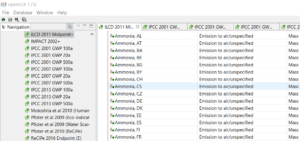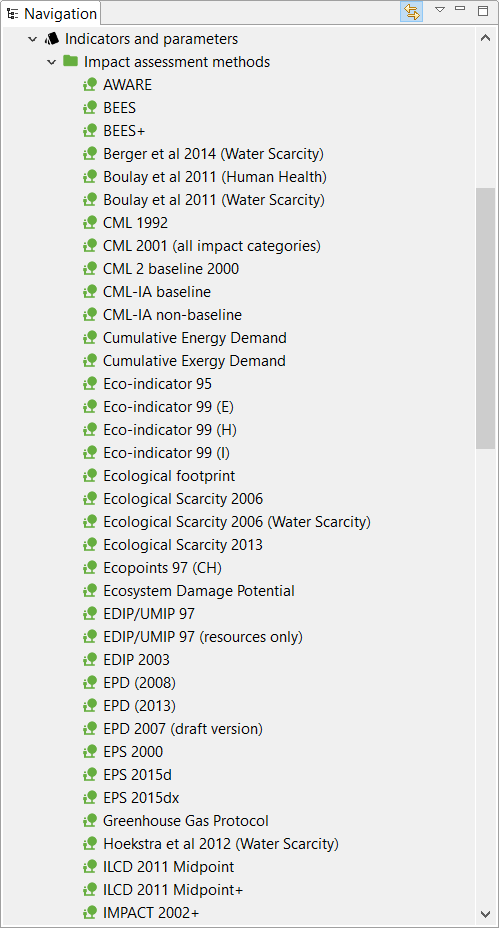A few attentive users already noticed and asked us about two new downloads on openLCA nexus which we would also like to announce publicly!
openLCA LCIA methods v2
With more than 70 LCIA methods openLCA LCIA methods v2 is the most comprehensive LCIA methods package that we have released so far (the full list is provided at the end of this blog post)! Some of the freshly introduced LCIA methods contain country-specific elementary flows e.g. ILCD 2011 Midpoint+ for Ammonia (see below). Country-specific refers to the fact that the respective elementary flows vary depending on the location at which they are emitted.

Please note that the country-specific openLCA LCIA methods are only compatible with regionalised databases though. At the point of writing this pertains ecoinvent 3.4 LCIA country specific (see below). We plan to provide more country-specific databased in the future.
ecoinvent 3.4 LCIA country-specific
Therefore, ecoinvent 3.4 LCIA country-specific contains (who would have guessed it?) country-specific flows that are compatible with the openLCA LCIA methods v2. The database is available in three versions:
- ecoinvent 3.4 APOS LCIA – country-specific
- ecoinvent 3.4 cut-off LCIA – country-specific
- ecoinvent 3.4 consequential LCIA – country-specific
Download
Both, the openLCA LCIA methods v2 and ecoinvent 2.4 LCIA country-specific, are available via nexus.openLCA.org. Check-out ask.openLCA.org if you have questions.
______________________________________
The following Life Cycle Impact Assessment (LCIA) methods are included in the openLCA LCIA methods v2.
 AWARE; BEES; BEES+; Berger et al 2014 (Water Scarcity); Boulay et al 2011 (Human Health); Boulay et al 2011 (Water Scarcity); CML 1992; CML 2001 (all impact categories);CML 2 baseline 2000; CML-IA baseline; CML-IA non-baseline; Cumulative Energy Demand; Cumulative Exergy Demand; Eco-indicator 95; Eco-indicator 99 (E); Eco-indicator 99 (H); Eco-indicator 99 (I); Ecological footprint; Ecological Scarcity 2006; Ecological Scarcity 2006 (Water Scarcity); Ecological Scarcity 2013; Ecopoints 97 (CH); Ecosystem Damage Potential; EDIP/UMIP 97; EDIP/UMIP 97 (resources only); EDIP 2003; EPD (2008); EPD (2013); EPD 2007 (draft version); EPS 2000; EPS 2015d; EPS 2015dx; Greenhouse Gas Protocol; Hoekstra et al 2012 (Water Scarcity); ILCD 2011 Midpoint; ILCD 2011 Midpoint+; IMPACT 2002+; IPCC 2001 GWP 100a; IPCC 2001 GWP 20a; IPCC 2001 GWP 500a; IPCC 2007 GWP 100a; IPCC 2007 GWP 20a; IPCC 2007 GWP 500a;IPCC 2013 GWP 100a; IPCC 2013 GWP 20a; IPCC 2013 GWP 500a; Motoshita et al 2010 (Human Health); Pfister et al 2009 (Eco-indicator 99); Pfister et al 2009 (Water Scarcity); Pfister et al 2010 (ReCiPe); ReCiPe 2016 Endpoint (E); ReCiPe 2016 Endpoint (H); ReCiPe 2016 Endpoint (I); ReCiPe 2016 Midpoint (E); ReCiPe 2016 Midpoint (H); ReCiPe 2016 Midpoint (I); ReCiPe Endpoint (E); ReCiPe Endpoint (H); ReCiPe Endpoint (I); ReCiPe Midpoint (E); ReCiPe Midpoint (H); ReCiPe Midpoint (I); Selected LCI results; Selected LCI results, additional; TRACI; TRACI 2; TRACI 2.1; USEtox (consensus only); USEtox (default); USEtox (recommended + interim); USEtox (sensitivity); USEtox 2 (recommended + interim); USEtox 2 (recommended only); USEtox Recommended; USEtox Recommended + Interim;
AWARE; BEES; BEES+; Berger et al 2014 (Water Scarcity); Boulay et al 2011 (Human Health); Boulay et al 2011 (Water Scarcity); CML 1992; CML 2001 (all impact categories);CML 2 baseline 2000; CML-IA baseline; CML-IA non-baseline; Cumulative Energy Demand; Cumulative Exergy Demand; Eco-indicator 95; Eco-indicator 99 (E); Eco-indicator 99 (H); Eco-indicator 99 (I); Ecological footprint; Ecological Scarcity 2006; Ecological Scarcity 2006 (Water Scarcity); Ecological Scarcity 2013; Ecopoints 97 (CH); Ecosystem Damage Potential; EDIP/UMIP 97; EDIP/UMIP 97 (resources only); EDIP 2003; EPD (2008); EPD (2013); EPD 2007 (draft version); EPS 2000; EPS 2015d; EPS 2015dx; Greenhouse Gas Protocol; Hoekstra et al 2012 (Water Scarcity); ILCD 2011 Midpoint; ILCD 2011 Midpoint+; IMPACT 2002+; IPCC 2001 GWP 100a; IPCC 2001 GWP 20a; IPCC 2001 GWP 500a; IPCC 2007 GWP 100a; IPCC 2007 GWP 20a; IPCC 2007 GWP 500a;IPCC 2013 GWP 100a; IPCC 2013 GWP 20a; IPCC 2013 GWP 500a; Motoshita et al 2010 (Human Health); Pfister et al 2009 (Eco-indicator 99); Pfister et al 2009 (Water Scarcity); Pfister et al 2010 (ReCiPe); ReCiPe 2016 Endpoint (E); ReCiPe 2016 Endpoint (H); ReCiPe 2016 Endpoint (I); ReCiPe 2016 Midpoint (E); ReCiPe 2016 Midpoint (H); ReCiPe 2016 Midpoint (I); ReCiPe Endpoint (E); ReCiPe Endpoint (H); ReCiPe Endpoint (I); ReCiPe Midpoint (E); ReCiPe Midpoint (H); ReCiPe Midpoint (I); Selected LCI results; Selected LCI results, additional; TRACI; TRACI 2; TRACI 2.1; USEtox (consensus only); USEtox (default); USEtox (recommended + interim); USEtox (sensitivity); USEtox 2 (recommended + interim); USEtox 2 (recommended only); USEtox Recommended; USEtox Recommended + Interim;
